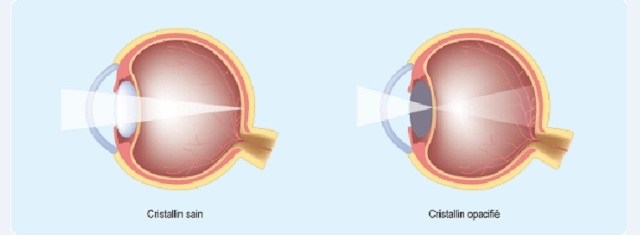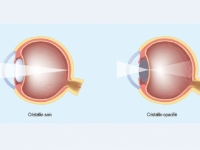Health
BREAKTHROUGH FROM CALIFORNIA SCIENTISTS DEVELOP CATARACT-DISSOLVING EYE DROPS
UNIVERSITY OF CALIFORNIA SAN DIEGO

(Source: © CNAMTS)
USPA NEWS -
Scientists at the University of California, San Diego have developed a treatment that's shown to shrink and even dissolve cataracts, the leading cause of blindness worldwide. Caratacts cloud the eyes of tens of millions of people around the world and around 17 % of Americans over the age of 40...
Cataracts are treated by a surgey in which the lens of the eye is removed and, in most of cases, replaced by an artificial one. It is a relatively common and generally safe procedure.
The World Health Organization gives a definition : "clouding of the lens of the eye which impedes the passage of light. Although most cases cataract are related to the aging process, occasionally children can be born with the condition, or a cataract may develop after eye injuries, inflammation, and some other eye deseases".
The World Health Organization gives a definition : "clouding of the lens of the eye which impedes the passage of light. Although most cases cataract are related to the aging process, occasionally children can be born with the condition, or a cataract may develop after eye injuries, inflammation, and some other eye deseases".
Until now, the only treatment available was surgery either by lasers or replacing the lens or using scalpels that extract the molecular "fog" that builds in the eyes as cataracts develop.
A team of scientists led by Molecular Ling ZHAO from University of California (UC), San Diego came up with an idea of an eye drop after finding that children with a genetically inherrited form of cataracts shared a mutation that prevents them from producing an important steroid, called lanosterol in the body. (Reported Biotechin.asia)
A team of scientists led by Molecular Ling ZHAO from University of California (UC), San Diego came up with an idea of an eye drop after finding that children with a genetically inherrited form of cataracts shared a mutation that prevents them from producing an important steroid, called lanosterol in the body. (Reported Biotechin.asia)
"Mission cataract USA" offers free cataract surgery to people of all ages who have no means to pay. The goal of Mission Cataract USA is to eradicate blindness due to cataracts in USA and bring as many people as possible from blindness to useful productive lives.
“There are many working people who need cataract surgery, but can´t afford to pay for it,“ explains Dr. Richburg. “They have no insurance and don´t qualify for Medicare, Medicaid, or any other form of governmental assistance.“
“There are many working people who need cataract surgery, but can´t afford to pay for it,“ explains Dr. Richburg. “They have no insurance and don´t qualify for Medicare, Medicaid, or any other form of governmental assistance.“
Steroid Lanosterol Researcher Molecular Biologist Surgery San Diego University Of California Artificial Treatment Americans Blindness Worldwide Procedure Affect Vision Eye Drug California Scientist Cataract Health Ruby Bird
Liability for this article lies with the author, who also holds the copyright. Editorial content from USPA may be quoted on other websites as long as the quote comprises no more than 5% of the entire text, is marked as such and the source is named (via hyperlink).






